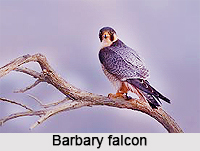 Barbary Falcon, an Indian bird with a scientific name "Falco pelegrinoides" is a medium-sized bird about the size of a crow. This bird of prey is mainly resident.
Barbary Falcon, an Indian bird with a scientific name "Falco pelegrinoides" is a medium-sized bird about the size of a crow. This bird of prey is mainly resident.
Concentration of Barbary Falcon
Barbary Falcon is a bird of semi-desert and dry open hills. Barbary falcon typically lays its eggs in cliff-ledge nests.
Structure of Barbary Falcon
Barbary Falcon is similar to the peregrine falcon, but smaller at 33 to 39 cm length with a wingspan of 76-98 centimetres. The female is larger than the male. It resembles its relative in general structure.
Sexes of Barbary Falcon
The adult Barbary falcons have paler grey-blue upperparts than the peregrine, and often have a buff wash to the barred under parts, whereas the larger species has a white background colour. The nape is rufous, but this is difficult to see. Sexes are similar, apart from size, but the young birds have brown upperparts and streaked under parts. The streaking is lighter than in the juvenile peregrine. Barbary falcon also bears some resemblance to the lanner falcon, but can be distinguished from that species at rest by the head-pattern, and in flight, by the proportions, flight action and under wing pattern.
Migration and the Residence of Barbary Falcon
Barbary Falcon is native to Northern and Eastern parts of Africa like Algeria, Egypt, Eritrea, Morocco, Niger, Sudan, Somalia, Tunisia and Yemen. It is also common in Middle East, Central Asia and South Asia, particularly in Afghanistan, China, India, Iran, Iraq, Israel, Jordan, Kazakhstan, Kuwait, Kyrgyzstan, Libya, Oman, Saudi Arabia, Syria, Tajikistan, Turkmenistan, United Arab Emirates, India and Uzbekistan. It is vagrant in Burkina Faso, Cameroon, Djibouti, Greece, Italy, Kenya, Lebanon, Mali, Malta, Nepal, Portugal, Qatar, Senegal and Turkey.
Appearance of Barbary Falcon
Barbary Falcon differs in appearance from the peregrine falcon according to Gloger`s rule. The genetic distance is slight and the species form a close-knit and somewhat paraphyletic group in DNA sequence analyses. They differ more in behaviour, ecology and anatomy than usual for conspecifics. They are able to produce fertile hybrids, but they are generally allopatric and only co-occur during breeding season in small areas such as the Maghreb, Punjab, Khorasan, and possibly the Mongolian Altai, and there is clear evidence of assortative mating with hybridization hardly ever occurring under natural conditions. In short, though they occupy adjacent territories, they breed at different times of year and Barbary falcons virtually never breed with peregrines in nature.
Existence of Barbary Falcon
Barbary Falcon has the fossil record which adds little to the issue. A humerus about 9,000 years old from the Aswan area in Sudan, where Falco peregrinus minor occurs today, was identified to belong to the peregrine. The Barbary falcon is one of the rare cases that may arguably be considered a species under the biological species concept, but certainly not under the phylogenetic species concept rather than the other way around as usual. This case demonstrates that what makes a "species" is not only its descent, but also occurs to a population in the course of evolution, how it adapts, and how this affects its reproductive isolation from sister taxa.



















